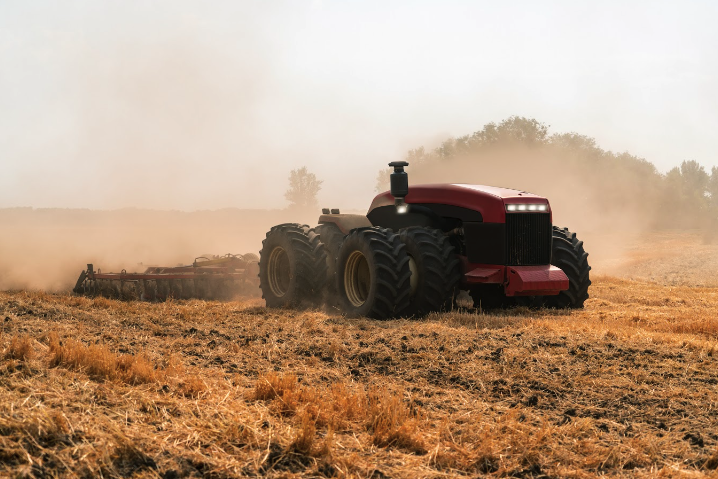Autonomous agriculture vehicles – the future of farming?
If you were born before 1995, you probably grew up thinking that by now, we would all have flying cars and robotic servants attending to our every need.
In reality, technology has advanced more slowly than the kids of the 70s and 80s thought it would. But we’re still seeing some incredible progress, particularly in automation.
A hot topic in the agriculture industry right now is the potential of autonomous agriculture vehicles to revolutionize farming.
Autonomous agricultural vehicles include everything from drones that can take soil samples and monitor crops from the air to robotic seed planters that can plant and fertilize in a single pass, to autonomous tractors that can literally give farmers extra hours in the day.
Autonomous farm vehicles have been generating a lot of interest since John Deere launched the world’s first fully autonomous tractor in Las Vegas in 2022 – so let’s take a look at this technology, and what it could mean for the future of farming.
What is an autonomous tractor?
An autonomous tractor is a driverless tractor that can be programmed and controlled by computer, so it doesn’t need a human driver in the cab.
John Deere has been pioneering autonomous tractor technology after launching the 8R410 – although what they actually launched was not an all-new tractor, but technology that could make an existing 8R autonomous.
This included fitting the vehicle with 12 stereo camera pods and making some changes to its transmission. As a result, the company says this technology will eventually be available for retrofitting to certain John Deere models, with the tractors able to be driven manually or autonomously.
Interest in the technology has been high because of significant labor shortages in the American agriculture industry and the length of time farmers currently have to spend sitting in their tractor cabs to perform large-scale operations such as tilling or cultivating.
How do autonomous tractors work?
Autonomous tractors work by using Satellite GPS and other advanced electronic controls without requiring a driver present.
In fact, much of this technology has already been in use for some time – the only difference is that in an autonomous tractor, the onboard computer systems can be controlled remotely, using a computer or mobile app. This is combined with a number of onboard GPS-enabled cameras and radar technology that allows the vehicle to ‘see’ where it’s going, and avoid obstacles.
The tractor can be programmed to follow a specific course, at a specific speed, with its operations tailored to suit the terrain, weather conditions and task being performed.
As the farming industry becomes ever more competitive, the autonomous capabilities and extreme precision offered by self-driving tractors is likely to fuel growing demand for the technology.
What are the benefits of autonomous tractors?
Autonomous tractors can save farmers a significant amount of time, given that they can spend up to 15 hours a day sitting in a tractor cab at key times of the year.
Driverless tractors allow farmers more time to focus on other work, increasing productivity on vital farming operations. These autonomous vehicles can also work at any time – including through the night, when workers are asleep.
For large-scale farms, autonomous technology holds a possible solution to increasing labor shortages – a problem that’s on the rise due to change in US immigration policy. Driverless tractors may also hold the key to helping US farmers feed a growing global population despite dwindling human resources.
Precision agriculture
Precision is another key benefit of automated vehicles, which eliminates human error that can push farming costs up. The technology could even have long-term benefits for the soil.
Farmers currently choose the biggest machines they can afford to get the most amount of work done in the least amount of time.
But take away those time constraints, they could perform the same task with smaller machines, reducing ecosystem disturbances and soil compaction.
Eventually, it could be the case that even the largest farms can operate a fleet of small, automated machines instead of a few huge ones.
What are the downsides of autonomous tractor technology?
The biggest obstacle to adoption of autonomous tractor technology is currently the cost.
Although innovations such as John Deere’s retrofitted technology are aimed at reducing capital costs, and other factors – such as labor savings – this will undoubtedly mitigate them too.
New technology safety concerns
There’s been a lot of debate around whether autonomous tractors are safe – what happens if a driverless vehicle becomes uncontrollable? Who will be liable for the damage? Again, advances in technology are all about easing these concerns.
Deere’s autonomous tractor for example, is programmed to stop if it detects an unexpected obstacle closer than 90 feet away – and will alert the farmer to perform a safety check or re-route before moving off again. The vehicle will also stop if its cameras or GPS systems go offline for any reason (though this can be a drawback if you farm in a cellular data blackspot).
Artificial intelligence use could impact jobs
There’s the suspicion that is currently impacting all industries – what will this mean for human jobs? It’s true that the use of autonomous agricultural vehicles could affect seasonal workers. But the type of jobs that can currently be carried out by driverless tractors is limited, so for now those jobs are likely safe.
In the future, it’s likely that autonomous vehicles will be able to do much more. With seasonal farm labor already in short supply, and dwindling numbers of young people coming into the farming profession, autonomous technology is likely to solve more problems than it creates.
Are automated vehicles the future of farming?
Autonomous tractors have a long way to go before they are widely adopted on US farms.
But other types of autonomous agriculture vehicles – such as drones – that were once regarded as a fad, have now become widely used and hugely valuable for farmers.
While there will always be those that prefer to do things the conventional way, it’s very likely that many will eventually embrace autonomous tractors and other autonomous machines in the same way.
As farming becomes more challenging due to climate change, labor shortages and rising costs, it’s possible that autonomous technology holds the key to global food security in the future.


